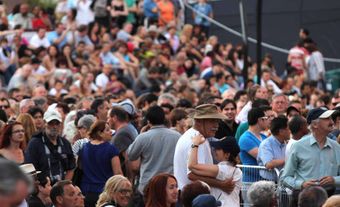Brantford, Ont
Brantford, Ont. Ontario settlement established in 1805 on the Grand River. It was named in 1827 in honour of the Mohawk chief Joseph Brant, and incorporated as a city in 1877. The population, under 10,000 in 1867, had increased to over 66,000 by 1975. Brantford's musical organizations of record (1850s) were two choral groups, Gideon's Band and the Brantford Choral Union, the latter conducted by A.W. Smith and accompanied by military band musicians from the British garrison there. Civilian brass bands (the Keller, the Philharmonic, the City, and the Grand Trunk) first appeared in the 1860s. The Brantford Philharmonic (choral) Society was founded in the 1870s with E.C. Kimpton as conductor and was reorganized in 1893 under Frederic Rogers. In 1881, with the opening of Stratford's Opera House in Brantford, the first theatre orchestra was formed. Other organizations active before World War I included the Dufferin Rifles Band (formed 1882); the Brantford Mendelssohn Society (1880s); the Brantford Operatic Society (1880s); the Brantford Musical Society (1896); the Brantford Male Chorus, founded in 1902 by A.D. Jordan and conducted 1903-6 by H.K. Jordan before assimilation into the newly formed Schubert Choir; and the Women's Musical Club, founded ca 1902 and renamed the Brantford Music Club in 1934. This club has presented many important performers in Brantford, eg, Maureen Forrester, Paul Frey, Glenn Gould, Alberto Guerrero, Ben Heppner, Viggo Kihl, Anton Kuerti, Luigi von Kunits, Winifred Lugrin Fahey, Lois Marshall, Ernest Seitz, Teresa Stratas, and Jon Vickers, as well as numerous choral groups and instrumental ensembles. To mark its 60th anniversary the Brantford Music Club, with assistance from the Canada Council, commissioned Harry Freedman's orchestral work Fantasy and Allegro (1962). The Ontario School for the Blind (later the W. Ross Macdonald School) was opened in 1872. B.F. Cheesbro of Vincennes, Ind, the school's first music director, devised musical notation in New York Point characters in 1874. With Frederick Lord's 1923 appointment as music director light opera became a part of the school's music program. Lord was followed by George S. Smale in 1945 and Smale by William Murphy in 1970. See also the Blind.
It was in Brantford in 1874 that Alexander Graham Bell invented the telephone: hence the city's popular name, 'Telephone City'. Bell's interest in sound took him to concerts at the Brantford Ladies' College and Conservatory of Music. Chartered in 1874 and thus one of the earliest conservatories in Canada, it was renamed the Brantford Cons in 1900 and affiliated with the University of Western Ontario in 1911. It flourished under the successive principals William Norman Andrews, Frederick C. Thomas, and Arthur G. Merriman until the building's sale in 1935 and then continued in the home of Merriman's widow for a few years. Other schools included the D.L. Wright Academy of Music (1908-20) and the (F.C.) Thomas School of Music (1920s).
Music in Brantford schools was organized in 1936 by G.A. Smale, who also in that year, with H.B. Jones and the Brantford Home and School Council, organized the Brant County Musical Festival, a competition designed to stimulate musical accompishment in public, separate, and secondary schools. Its successor, the Brantford Music Festival, began in 1945 under the auspices of the Brantford branch of the ORTMA and the Kiwanis Club.
Performing groups active after World War I included the Brantford Oratorio Society formed in 1917 and conducted in turn by J.W. Schofield and F.C. Thomas; a Brantford SO, formed in 1923 and briefly active under Thomas; the Canadian Choir (1928-45), founded and conducted by Frederick Lord; the Cockshutt Male Choir (1935-60, sponsored by the Cockshutt Plow Co), conducted by Frank Holton, G.A. Smale, and Lansing MacDowell; Smale's Varié Singers (1937-45); and the Frank Holton Mixed Choir and Ladies Choir. The Brantford Symphony Orchestra (see Orchestras) was established in 1949.
Brantford is the birthplace of the lyricist Alfred Bryan (1871-1958), who wrote 'Peg My Heart' and 'Come Josephine in My Flying Machine'; the conductor composer Morley Calvert; the educator Philip Cady Hayden; the songwriter Wade Hemsworth; and the soprano Phyllis Mailing. In October 1909 a meeting in Brantford between Albert Ham and several of the city's organists led to the founding in December of the Canadian Guild of Organists (subsequently the CCO and later the RCCO). On an island in the Grand River, in an outdoor concert held 3 Aug 1978 to raise money for the renovation of the Capitol Theatre, the Boston Pops Orchestra, conducted by Arthur Fiedler, made its first Canadian appearance in 20 years to play for an estimated audience of 30,000. Although the concert attracted a large audience, it failed as a fundraising event and the renovation of the theatre did not take place until the city bought the property in 1985. The renovated Capitol Theatre, restored to its original 1920s' elegance at a cost of $6 million and renamed The Sanderson Centre for the Performing Arts, reopened in September 1990 and is the site of Brantford SO concerts.

 Share on Facebook
Share on Facebook Share on X
Share on X Share by Email
Share by Email Share on Google Classroom
Share on Google Classroom

